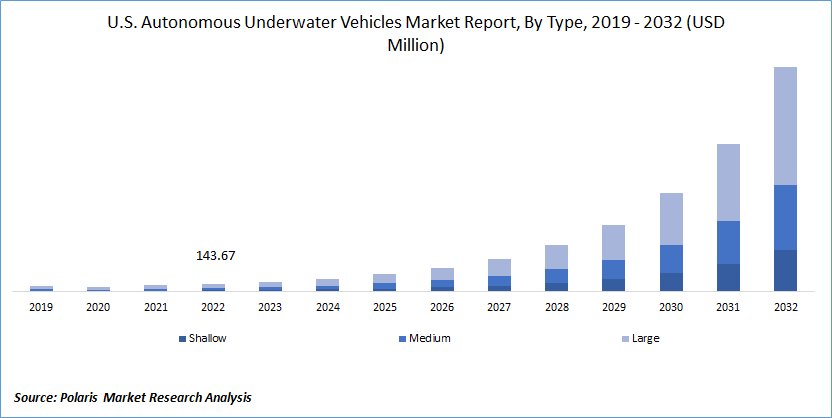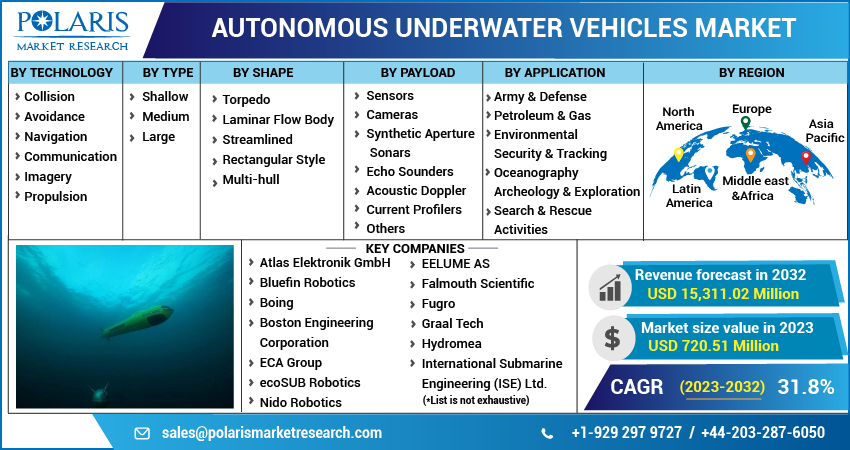
Autonomous Underwater Vehicles Market Share, Size, Trends, Industry Analysis Report, By Technology; By Type (Shallow, Medium and Large); By Shape; By Payload; By Application; By Region; Segment Forecast, 2023 - 2032
- Published Date:May-2023
- Pages: 116
- Format: PDF
- Report ID: PM1712
- Base Year: 2022
- Historical Data: 2019-2021
Report Outlook
The global autonomous underwater vehicles market was valued at USD 572.97 million in 2022 and is expected to grow at a CAGR of 31.8% during the forecast period. The market is experiencing significant growth due to its wide range of applications in commercial, scientific, and military sectors. These vehicles are utilized in various fields, such as oceanography, anti-submarine warfare, and ocean exploration. AUVs are equipped with sensors, actuators, and onboard intelligence systems, allowing them to autonomously perform tasks like surveying, sampling collection, and underwater inspections without human intervention.

To Understand More About this Research: Request a Free Sample Report
In oceanographic research, AUVs have proven to be cost-effective tools for scientific sampling of the ocean. They can collect water temperature, salinity, currents, and marine life data, providing valuable insights for studying marine ecosystems. Additionally, AUVs are crucial in tracking illegal activities such as human and drug trafficking and smuggling operations. Their ability to navigate underwater and gather intelligence makes them indispensable in security operations.
The oil and gas industry is another significant consumer of AUVs. These vehicles inspect and repair submerged infrastructure, such as pipelines and offshore platforms. They aid in efficiently monitoring underwater equipment and ensuring the smooth functioning of oil and gas operations. Moreover, AUVs find applications in port and harbor security projects, assisting in environmental assessment, detection of explosives, and monitoring activities within these critical areas.
However, the COVID-19 pandemic has impacted the growth of the autonomous underwater vehicle market. The restrictions and lockdown measures implemented worldwide led to a decline in demand for oil and gas, affecting the production and deployment of AUVs in the industry. The limited mobility of laborers operating these vehicles at various sites further hindered the market's growth during the pandemic.
Nevertheless, as the global situation improves and restrictions are gradually lifted, the AUV market is expected to recover. The need for efficient and autonomous underwater operations will continue to drive the demand for these vehicles in various sectors. Advances in technology, such as improved navigation systems and enhanced data collection capabilities, will further contribute to the growth of the AUV market. Additionally, the ongoing research and development efforts to enhance the capabilities and efficiency of AUVs will unlock new opportunities for their deployment in future applications.

For Specific Research Requirements, Request for a Customized Report
Industry Dynamics
Growth Drivers
The utilization of autonomous underwater vehicles (AUVs) in oceanographic studies has experienced significant growth, driven by their advantages in precise data collection and improved spatial coverage. Equipped with various sensors and instruments, AUVs can collect data on physical and chemical properties, biodiversity, and ecosystem dynamics in the marine environment. Compared to traditional methods, AUVs offer higher-resolution data, autonomy for extended periods, and flexibility in study design, enhancing the efficiency and cost-effectiveness of oceanographic research. They contribute to advancements in understanding ocean phenomena and support the development of models, predictions, and conservation strategies.
As the importance of oceanographic research increases, the utilization of AUVs is expected to expand further. Technological advancements will enable more comprehensive and sophisticated studies, including improved autonomy, enhanced sensing capabilities, and AI and machine learning integration. AUVs are crucial in advancing our knowledge of the marine environment, supporting ongoing research efforts, and facilitating sustainable management of marine resources.
Report Segmentation
The market is primarily segmented based on technology, type, shape, payload application, and region.
|
By Technology |
By Type |
By Shape |
By Payload |
By Application |
By Region |
|
|
|
|
|
|
To Understand the Scope of this Report: Speak to Analyst
The navigation technology segment generated the highest market revenue in 2022
Navigation technology generated the highest market revenue in 2022, ensuring accurate data collection during extended underwater missions. Submarine navigation technology provides precise velocity, position, and attitude information for AUVs. It guarantees reliable and geo-referenced data, enabling informed decision-making. With autonomous operations and real-time data, AUVs can adjust their trajectory and maintain optimal positioning, improving efficiency and reducing human supervision.
Enhanced safety and energy optimization further contribute to the industry's growth. The increasing demand for AUVs with advanced navigation capabilities across sectors drives the evolution of navigation technology with cutting-edge sensors and algorithms. Accurate navigation information accelerates industry growth by ensuring data quality, enabling autonomy, and enhancing safety and efficiency in longer AUV missions.
Large AUVs segment dominants in the market in 2022
The military & defense sector and the oil & petroleum industry are driving the demand for large AUVs, making them the dominant segment in the market. These AUVs are equipped with diverse sensors and facilitate the seamless integration of navigation systems. The large size of these AUVs allows for the incorporation of advanced navigation technology, enabling precise positioning and accurate data collection.
The military & defense sector benefits from the capabilities of large AUVs for surveillance and reconnaissance purposes, while the oil & petroleum industry relies on them for pipeline inspections and underwater infrastructure monitoring. The versatile nature of large AUVs contributes to their significant market share.
North America dominated the global market in 2022
North America dominated the global market in 2022 due to the growing need for autonomous underwater vehicles in the region’s emerging markets is expected to boost the demand for AUVs. These vehicles are utilized in the U.S. for several marine projects. It offers marine support roles such as mine countermeasures, inspection and identification, Intelligence, Surveillance and Reconnaissance (ISR), oceanography, and payload delivery.
Asia Pacific is likely to witness a significant share over the forecast period. The autonomous underwater vehicles market growth in the region is mainly driven by the demand for AUVs from countries like India and China. Autonomous underwater vehicles are largely employed in the marine sector in India to combat maritime security threats.
Competitive Insight
Some of the major players operating in the global autonomous underwater vehicles market include Atlas Elektronik GmbH, Bluefin Robotics, Boing, Boston Engineering Corporation, ECA Group, ecoSUB Robotics, EELUME AS, Falmouth Scientific, Fugro, Graal Tech, Hydromea, International Submarine Engineering (ISE) Ltd., Kongsberg Groups, L3Harris Technologies, Lockheed Martin Corporation, Nido Robotics, Oceanserver Technology, Riptide Autonomous Solutions, Saab Group, Lockheed Martin Corporation, Teledyne Technologies, Terradepth, and Tianjin Sublue.
Recent Developments
- In September 2021, Fugro secured a contract from TotalEnergies to conduct investigations at a Geohazard Site in Suriname. The project involved acquiring geophysical data and collecting geotechnical soil samples.
- In April 2021, Fugro was awarded a contract by Equinor to perform a deep-water sea site investigation in the Canadian Flemish Pass. The survey utilized Fugro's latest autonomous underwater vehicle, the Echo Surveyor VIII.
Autonomous Underwater Vehicles Market Report Scope
|
Report Attributes |
Details |
|
Market size value in 2023 |
USD 720.51 million |
|
Revenue forecast in 2032 |
USD 15,311.02 million |
|
CAGR |
31.8% from 2023 – 2032 |
|
Base year |
2022 |
|
Historical data |
2019 – 2021 |
|
Forecast period |
2023 – 2032 |
|
Quantitative units |
Revenue in USD million and CAGR from 2023 to 2032 |
|
Segments Covered |
By Technology, By Type, By Shape, By Payload, By Application, By Region |
|
Regional scope |
North America, Europe, Asia Pacific, Latin America; Middle East & Africa |
|
Key Companies |
Atlas Elektronik GmbH, Bluefin Robotics, Boing, Boston Engineering Corporation, ECA Group, ecoSUB Robotics, EELUME AS, Falmouth Scientific, Fugro, Graal Tech, Hydromea, International Submarine Engineering (ISE) Ltd., Kongsberg Groups, L3Harris Technologies, Lockheed Martin Corporation, Nido Robotics, Oceanserver Technology, Riptide Autonomous Solutions, Saab Group, Lockheed Martin Corporation, Teledyne Technologies, Terradepth, and Tianjin Sublue.. |
FAQ's
key companies in autonomous underwater vehicles market are Elektronik GmbH, Bluefin Robotics, Boing, Boston Engineering Corporation, ECA Group, ecoSUB Robotics, EELUME AS, Falmouth Scientific.
The global autonomous underwater vehicles market expected to grow at a CAGR of 31.8% during the forecast period.
The autonomous underwater vehicles market report covering key segments are technology, type, shape, payload application, and region.
key driving factors in autonomous underwater vehicles market are growing demand in the military & defense sector.
The global autonomous underwater vehicles market size is expected to reach USD 15,311.02 million by 2032.
